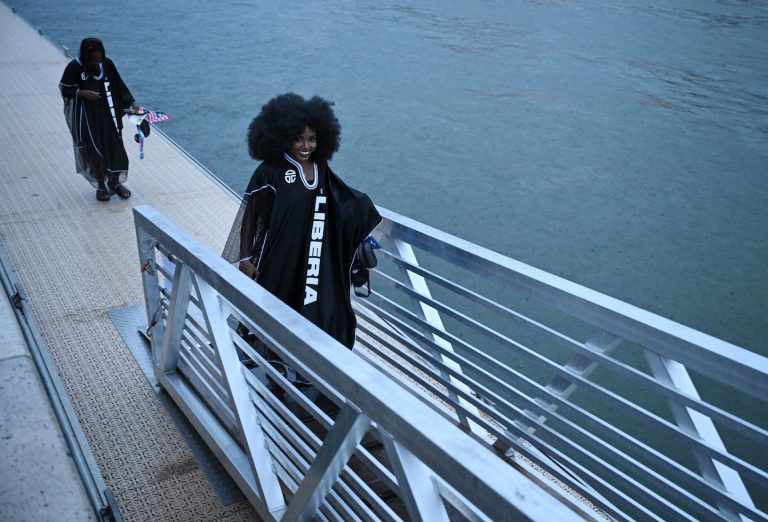Watching one of the few indisputable moments that are usually a display of pride, unity, good-natured competition and patriotism in the run-up to the 2024 Olympics, it was hard not to feel like fashion had consumed it all.
LVMH, the Paris-based conglomerate that owns most of the world’s biggest fashion brands and has made its founder and CEO, Bernard Arnault, one of the world’s richest people, is a major sponsor of the Olympics. The company is synonymous with the host city — Paris, after all, is the metropolis that invented fashion as we know it today: its dazzling, sometimes irrational and fleeting quest for self-reinvention.
But fashion at the Olympics, and LVMH’s presence in particular, quickly became more commercial and cutthroat, celebrating brand rather than craftsmanship.
The night before the opening ceremony, Arnault hosted a party at his museum, the Fondation Louis Vuitton. Many athletes, including LeBron James, Jelena Djokovic (wife of Serbian tennis player Novak Djokovic), Angel Reese and Naomi Osaka, attended wearing clothes that prominently featured the LVMH logo. A few others wore more modest clothes and carried Louis Vuitton bags. Public opinion of designer goods tends to go up and down. At a time when global inequality is on the rise and the prices of luxury brands are rising, nothing seems more tacky than designer bags and brands.
Now it’s not fashion that gets people excited about clothes, it’s style. What’s made the tunnel style of the NBA, and now the WNBA, so appealing is the sense that the players are creating their own style. They may use stylists, but you can tell there’s something other than money involved with the clothes they’re wearing. Some of the designers that WNBA players dress have told me they had no idea the players were wearing their clothes.
Louis Vuitton, LVMH’s biggest brand, designed the medals and torch cases; Berluti, the LVMH-owned tailoring house, made the uniforms for the French opening ceremony; jeweler Chaumet designed the medals; Moet was on hand for the victory moment; Sephora sponsored the torch relay. There’s always some branding — Ralph Lauren did the U.S. uniforms, for example, and has done so at several previous Olympic Games — but this year it feels like sponsors have turned every moment into a collaboration.
During the opening ceremony, I was bombarded with dozens of press from brands. Lady Gaga wore Dior. Jessica Chastain wore Ralph Lauren. Ariana Grande wore Thom Browne. Cynthia Erivo wore Roberto Coin. LVMH made the uniforms of the volunteer medal holders! Dior by Maria Grazia Chiuri even made the costumes for the choirgirls!
I get it. It’s lucrative to wear designer clothes. Most celebrities, Olympic and otherwise, don’t just wear them because they like them. And yes, fashion is France’s national treasure, so the opening ceremony’s whimsical display of the Moulin Rouge ladies dancing the cancan in pink and the glamorous (if cheesy) runway shows were certainly appealing.
But the problem wasn’t the pairing of celebrity and sport, it was the ubiquity of the brand. At Friday’s opening ceremony, a masked torchbearer in a tattered tailcoat stormed into a room that was supposed to be a Louis Vuitton atelier. Cameras panned gleefully to workers carefully stitching the monogrammed coated canvas and leather that adorns many of the brand’s handbags and accessories. It felt, at least for now, like an awkward, sentimental ad, if a little jarring.
Every time the camera cut to French President Emmanuel Macron and his wife Brigitte Macron, the focus wasn’t on the French swimmer Laure Manaudou, but on the belt she was wearing, with “Alexander Wang” emblazoned in loud letters.
The world probably felt this way when sports stadiums with historic names were demolished and replaced with spaces with names like “Smoothie King Center.”
All this creates an atmosphere of crudeness where there should be joy, ideally beauty and even a touch of sentimentality.
It was unusually moving this year to see players appear in national dress, although there are always teams who choose to wear costumes that have some traditional connection to their country as a source of national pride.
But seeing Ghanaians in blue stripes and hats, Indians in deep pastel prints, and Haitians in textured trousers and skirts, in a city that sees clothing as its mother tongue and often feels superior to its own sartorial creations, it was a stark reminder that many people from around the world have something interesting to say with their clothes.
Particularly significant was the uniform, a modern take on traditional clothing that brings the country’s history into the present: Designed by fashion brand Michel & Amazonka, Mongolia’s deep cornflower blue and red tunic is based on a “dhir,” a wraparound coat often worn by nomads, and is decorated with Olympic and Mongolian imagery.
The Liberian outfits were designed by Liberian-American designer Telfar Clemens for the second consecutive Summer Olympics, and his tote bags, affectionately nicknamed the “Bushwick Birkin,” have become an affordable, trending bag beloved by Gen Z and millennials. This is a country where designers fled civil war and now, as homegrown natives, are embracing out-of-place talent, and thus the clothes create meaning.
Because, of course, clothes aren’t just about fashion: the joy of the pink cancan dancers and Lady Gaga dancing in ostrich feathers and Dior feather hats were brazen tributes to French tradition.
But fashion can also be conservative and insular, pointlessly snobbish and overly attached to tradition and authority — and, most importantly, it has a long history of exclusivity, even while borrowing from cultures it otherwise despises.
Seeing people all over the world blossom with expression, even if it was just a single outfit – hats, scarves and colorful blazers – was the Olympics at its best and a celebration of the truth that style and self-expression are often the richest stories.


